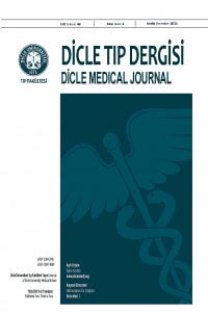Common pathogens isolated from burn wounds and their antibiotic resistance patterns
Yanık yaralarından izole edilen patojenler ve antibiyotik direnç durumları
___
- 1. Manson WL, Pernot PC, Fidler V, et al. Colonisation of burns and the duration of hospital stay of severely burned patients. J Hospital Infect 1992;22:55-63.
- 2. Tekin R, Yolbas I, Selcuk CT, et al. An evaluation of pediatric burn patients over a 15-year period. Turk J Trauma & Emergency Surg 2012;18:514-518.
- 3. Revathi G, Puri J, Jain BK. Bacteriology of burns. Burns 1998;24:347-349.
- 4. Davis SC, Pisanni F, Montero RB. Effects of commonly used topical antimicrobial agents on Acinetobacter baumannii: an in vitro study. Mil Med 2008;173:74-78.
- 5. Peleg AY, Seifert H, Paterson DL. Acinetobacter baumannii: emergence of a successful pathogen. Clin Microbiol Rev 2008;21:538-582.
- 6. Tredget EE, Shankowsky HA, Rennie R, et al. Pseudomonas infections in the thermally injured patient. Burns 2004;30:3-26.
- 7. Sengupta S, Kumar P, Ciraj AM, Shivananda PG. Acinetobacter baumannii-an emerging nosocomial pathogen in the burns unit Manipal, India. Burns 2001;27:140-144.
- 8. Ananthakrishnan AN, Kanungo R, Kumar K, Badrinath S. Detection of extended spectrum beta lactamase producers among surgical wound infections and burns patients in JIPMER. Ind J Med Microbiol 2002;18:160-165.
- 9. Greenhalgh DG, Saffle JR, Holmes JH, et al. American Burn Association consensus conference to define sepsis and infection in burns. J Burn Care Res 2007;28:776-790.
- 10. Ekrami A, Kalantar E. Bacterial infections in burn patients at a burn hospital in Iran. Indian J Med Res 2007;126:541- 544.
- 11. Frame JD, Kangesu L, Malik WM. Changing flora in burn and trauma units: experience in United Kingdom. J Burn Care Rehabil 1992;13:281-286.
- 12. Amin M, Kalantar E. Bacteriological monitoring of hospital borne septicemia in burn patients in Ahvaz, İran. Burn Surgical Wound Care 2004;3:4-8.
- 13. Nasser S, Mabrouk A, Maher A. Colonization of burn wounds in Ain Shams University Burn Unit. Burns 2003;29:229-233.
- 14. Singh NP, Goyal R, Manchanda V, et al. Changing trends in bacteriology of burns in the burns unit, Delhi, İndia. Burns 2003;29:129-132.
- 15. Revathi G, Puri J, Jain BK. Bacteriology of burns. Burns 1998;24:347-349.
- 16. Erol S, Altoparlak U, Akcay MN, et al. Changes of microbial flora and wound colonization in burned patients. Burns 2004;30:357-361.
- 17. Aksaray S, Cesur S. Microorganisms isolated from wound and blood culture of burn patients and their antibiotic susceptibility. Turkish J İnfect 2003;17:293-296.
- 18. Babik J, Bodnarova L, Sopko K. Acinetobacter-serious danger for burn patients. Acta Chir Plast 2008;50:27-32.
- 19. Rezaei E, Safari H, Naderinasab M, Aliakbarian H. Common pathogens in burn wound and changes in their drug sensitivity. Burns 2011;37:805-807.
- 20. Albrecht MC, Griffith ME, Murray CK, et al. Impact of Acinetobacter infection on the mortality of burn patients. J Am Coll Surg 2006;203:546-550.
- ISSN: 1300-2945
- Yayın Aralığı: 4
- Başlangıç: 1963
- Yayıncı: Cahfer GÜLOĞLU
Önemli bir tetraparezi nedeni: Servikal spondilotik miyelopati
Eksternal dakriosistorinostomide tek flepli bikanaliküler silikon tüp entübasyonu sonuçlarımız
Çiğdem HARMANCI, Zeynep ÇAKMAK, Ece KIRANDİ, Fatih TOKA
Gebelikte hiperparatiroidizm: İki olgu sunumu
Adem GÜNGÖR, Habib BİLEN, EMİN MURAT AKBAŞ, Çiğdem ÖZDEMİR, Bülent AKTAN
Adölesan dönemi ve öncesinde yapılan sünnetlerin karşılaştırılması
Mehmet Mazhar UTANĞAÇ, Mansur DAĞGÜLÜ, İsmail YAĞMUR
Safra kesesi malign lenfoması: Nadir bir olgu
Ebubekir GÜNDEŞ, Ahmet TEKİN, Enes FERLİBAŞ, Ali BAL, Hacı Hasan ESEN
İndirek hiperbilirubinemili yenidoğanlarda fototerapinin oksidatif stres üzerine etkisi
EMEL TORUN, Bilge TANYERİ, Nursel ÜNSAL, AYŞEGÜL DOĞAN DEMİR, Süleyman BAYRAKTAR, Faruk ÖKTEM
Primer pterjiumda konjonktivalimbal otogreft transplantasyonu sonuçlarımız
Clinical analysis and follow-up results of children with vasovagal syncope
Ahmet Midhat ELMACI, FATİH AKIN, Sevim KARAARSLAN
Acquired tufted angioma: Case report
Recep BEDİR, HASAN GÜÇER, Esra Zeynep COŞKUNOĞLU, İbrahim ŞEHİTOĞLU
Common pathogens isolated from burn wounds and their antibiotic resistance patterns
İLYAS YOLBAŞ, Recep TEKİN, Selvi KELEKÇİ, Cafer Tayyar SELÇUK, M Hanefi OKUR, İlhan TAN, Ünal ULUCA
